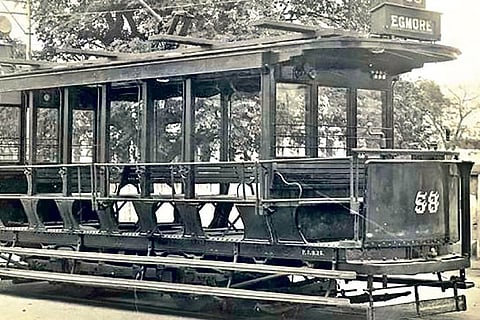

Chennai
On April 12, 1953, Madras lost a heritage transport system. The tram service, which for 60 years had been moving whopping slices of the city’s populace albeit slowly at seven miles an hour, was shut forever.
Introduced in the late 19th Century and run by the Madras Electricity System, trams on rails remained a convenient mode of transport, thus replacing thousands of bullock carts and horse-drawn jutkas. The trams were slow that passengers could jump off and get on the vehicle while it was moving and wobbled with a characteristic gait.
Ironically, when it commenced in 1895, people thought it was fast and unsafe and refused their valued patronage. Free rides were offered for a few days before they were charged and people started feeling comfortable. Soon it became a preferred mode and an integral part of Madras culture. Poetry booklets like the Tram Vandiyin Alangara Kummi talked about the tram system. At its height, 97 cars were running on 24 km of track and ferried one lakh passengers a day. The mainline ran from Parry’s Corner to Luz junction, passing through the Central station area. The east-west line shuttled between Central and Roxy at Purasaiwalkam.
There were two sizes of trams. The longer, 50-ft size, and the smaller, 35-ft one, drove on rails embedded in the main roads of the city, some very narrow like the Kutchery Road, Mylapore. While the first 60 to catch the tram car could occupy polished wooden seats with back-rests, peak hours saw passengers standing and struggling for space with footboard riding a common sight. However, a total of 150 commuters could conveniently travel on trams.
It was a pretty noiseless system other than the warning metallic clangs, meant to alert other vehicles and the occasional high-pitch noise that emanated when the driver changed gears. The tram ran on electricity and had a rod with a small wheel on it. This contributed to the undoing of the system.
In the late 1940s, the company which ran the system claimed a loss of Rs 50,000 every month. The government took over the electricity company and raised the charges, nullifying a 50-year-old contract. On July 29, 1949, the company had submitted a petition to the Minister for Public Works, complaining about the increased charges, and pointing out how it had been carrying one lakh citizens of Madras daily at cheap rates for years.
The letter also pointed out how the company had begun to work at a loss, was unable to pay any dividend and how its financial condition had deteriorated progressively. The government disagreed and in a last-ditch effort, the company wanted to sack 300 people and improve the economics of the company. But the unions were adamant.
The tramway shut down and PG Brookes was appointed as a receiver for the company on behalf of the debenture owners. The relationship between the workers and the management had also been widening and hence the tramcars were safely enclosed in the compound before the announcement of the closure came, lest they damage the vehicles. The police as a precaution put up extra pickets around the tram shed in Egmore and Mylapore where 1,651 workers were thrown out of jobs by the decision.
The Communist union and the Congress union of the tram workers met in separate meetings on the beach. (The Congress union was led by R Venkataraman who would rise to become the President of the country later). They requested the government to take over the system to save the jobs. The Madras government, the Railways and the corporation showed no interest. But everyone wondered how the city would survive without trams when it opened after a long weekend. Since Tamil New Year Day was a holiday, the city waited in suspense on how people would get to their workplace the day after. As an emergency, the government said it would let out an extra 50 busses on the tram routes. But then came Tuesday and most made it to their offices, a little later though.
Madras could live without its trams. But to their credit, trams had enabled people to move longer distances to work and thus contributed to the economic growth of spots like George Town and populating newer locations in the city. Trams were the impetus for the growth and survival of the city. However, the pace of life was increasing in the post-war boom. More cars were on the road, busses and suburban trains moved faster. The trams were suddenly becoming obsolete. Trams were becoming slow-paced snails in the world of racing horses. And as expected when it was withdrawn in 1953 there were no protests or pleadings from the consumer side. Life resumed on its own a day after the company collapsed. The only reminder was the rails on the road which were not removed for a long time due to the prohibitive costs and vehicles like rickshaws and cycles occasionally tripping on them.
— The author is a historian
Visit news.dtnext.in to explore our interactive epaper!
Download the DT Next app for more exciting features!
Click here for iOS
Click here for Android